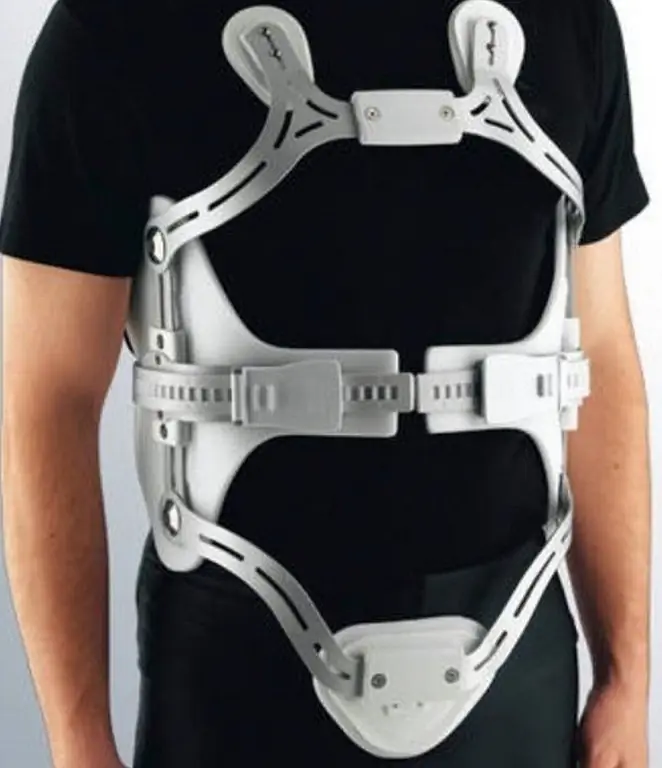- Author Rachel Wainwright [email protected].
- Public 2023-12-15 07:39.
- Last modified 2025-11-02 20:14.
Dorsopathy
Brief description of the disease

Nowadays, the term "dorsopathy" refers to a number of pain syndromes associated with degenerative changes in the spine. In fact, lumbar dorsopathy is analogous to osteochondrosis of the spine - a long-term chronic disease with characteristic exacerbations and the appearance of sharp pain. In addition to the lumbar region, changes can affect other parts of the body. In particular, doctors are well aware of cervical dorsopathy caused by damage to the cervical vertebrae.
Nevertheless, the lumbar spine still suffers much more often, and therefore in our article we will focus specifically on the dorsopathy of the spine. The main cause of degenerative changes is osteochondrosis - an unfavorable process that develops in the intervertebral discs, joints and ligaments. It is characterized by acute, prolonged pain and a chronic course. At the same time, painful episodes are very frequent, and a person can suffer from exacerbation attacks more than 25 times a year. Chronic dorsopathy of the lumbar spine is observed in 17% of adults. Treatment prognosis is usually poor because the changes have too much impact on the structure and structure of the spine.
Classification of dorsopathies
According to international standards, all types of dorsopathy can be divided into three large groups:
- deforming - this group includes: lordosis, kyphosis, scoliosis, spondylolisthesis, osteochondrosis and subluxation;
- spondylopathies - includes all types of inflammatory, degenerative and traumatic spondylopathies;
- other dorsopathies are represented by degeneration of intervertebral discs, sympathetic syndromes and dorsalgia (dorsopathy of the cervical spine, in which there is no damage to the intervertebral discs).
Dorsopathy treatment
If a person is diagnosed with dorsopathy, treatment is prescribed taking into account the form of the disease and the clinical picture of its development. Currently, medicine uses medication, non-medication and surgical methods to get rid of joint pain.
During periods of exacerbation, the patient is shown bed rest. In this case, a person must not only give up physical activity for 5-6 days, but also take the so-called antalgic (protective) pose as often as possible. Since dorsopathy of the lumbar spine is exacerbated by excessive activity, the patient is recommended immobilizing orthoses, which limit the mobility of the vertebrae. They are quite effective, but they can cause muscle hypertrophy, so they should be used with caution and only after consulting a specialist.
An indispensable stage of treatment is taking painkillers. If the pain is weak and not very intense, then non-opioid analgesics (benalgin, tempalginol, spazmalgon, sedalgin-neo) would be the ideal choice. For severe pain, nonsteroidal anti-inflammatory drugs are prescribed, but they are again taken with caution to avoid side effects, in particular, gastropathy. We recommend using such preparations in the form of suppositories. They are quite safe and easily absorbed by the body. If the dorsopathy of the spine does not go away, and the pain sensations intensify over time, then you can combine the use of non-steroidal anti-inflammatory drugs and opioid analgesics. A positive effect is observed with the use of antihistamines, anticonvulsants and antidepressants.

In the acute period, in addition to analgesics, the patient is shown warming ointments. In our country, the most famous are: Fastum-gel, Espol, Efkamon and Espol. You can buy them at any pharmacy.
If the patient is diagnosed with dorsopathy on time, treatment can be carried out without the use of medication. In this case, a person is prescribed physiotherapy procedures, therapeutic exercises, magnetotherapy and laser therapy. As a rule, the course of treatment lasts no more than one month, but it must be borne in mind that medications can be dispensed with only in the early stages of the disease, when degenerative changes have not yet had a significant impact on the spine.
As for surgical treatment, it is rarely required. According to existing statistics, only 0.3% of all patients with lumbar dorsopathy require surgery. As a rule, it is prescribed for acute compression of the spinal cord, paresis, and severe bilateral pain. Surgical intervention is also desirable if the dorsopathy of the spinal region manifests itself for 5 or more months, and standard drug treatment is ineffective.
YouTube video related to the article:
The information is generalized and provided for informational purposes only. At the first sign of illness, see your doctor. Self-medication is hazardous to health!






